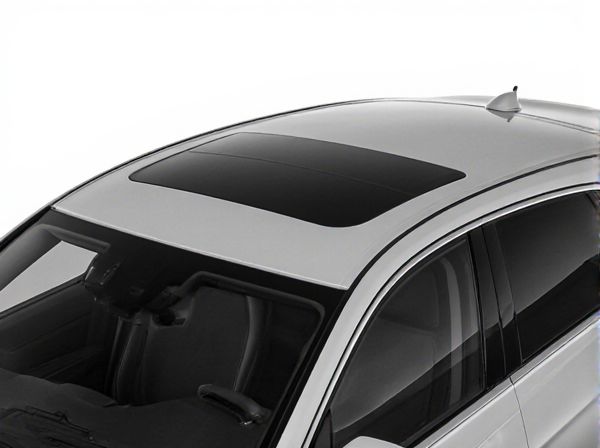
Photo illustration: Panoramic Roof vs Sunroof
A panoramic roof offers a larger, fixed glass panel that covers most of the car's roof, providing an expansive view and increased natural light inside the vehicle. A sunroof typically consists of a smaller, operable panel that can tilt or slide open to allow fresh air and sunlight. Choosing between a panoramic roof and sunroof depends on your preference for a more open cabin feel versus the ability to ventilate your car.
Table of Comparison
| Feature | Panoramic Roof | Sunroof |
|---|---|---|
| Design | Large glass panel covering most of the roof | Smaller glass or metal panel, typically over front seats |
| Visibility | Enhanced natural light and wide sky view | Limited natural light, focused on front passengers |
| Ventilation | Often fixed or partially openable | Fully openable for better airflow |
| Cost | Higher installation and repair cost | More affordable option |
| Weight | Heavier due to large glass area | Lighter, smaller panel |
| Privacy | Lower, due to large see-through surface | Higher, can be closed completely |
| Common Uses | Luxury and premium cars | Wide range including economy and mid-range cars |
Introduction to Panoramic Roofs and Sunroofs
Panoramic roofs are expansive glass panels that extend over both the front and rear seats, offering enhanced natural light and an open-air feel in vehicles. Sunroofs are smaller, typically operable panels that allow ventilation and light, usually positioned above the front seats. Both features improve driving experience but differ in size, functionality, and design impact on the vehicle's interior ambiance.
Key Differences Between Panoramic Roofs and Sunroofs
Panoramic roofs typically span a larger portion of the vehicle's roof, offering expansive views and greater natural light compared to standard sunroofs, which are smaller and often limited to a single panel. Panoramic roofs are usually made of multiple glass panels that can be fixed or partly open, while sunroofs are generally a single movable glass or metal panel. The structural design and installation of panoramic roofs often require reinforced roof frames for safety and durability, whereas sunroofs involve simpler modifications and are more common in various vehicle models.
Advantages of Panoramic Roofs
Panoramic roofs offer a larger glass surface, providing enhanced natural light and an expansive view compared to traditional sunroofs. They improve the sense of space inside the vehicle, creating a more open and airy cabin atmosphere. These roofs often feature advanced UV protection and improved insulation, increasing passenger comfort and energy efficiency.
Benefits of Choosing a Sunroof
A sunroof offers enhanced ventilation and natural light, improving the overall driving experience by allowing fresh air and sunlight to enter the cabin. It typically provides a more affordable and easier-to-install option compared to panoramic roofs, making it accessible for a wider range of vehicles. Sunroofs also tend to have simpler mechanisms, resulting in lower maintenance costs and increased reliability for daily use.
Drawbacks and Limitations: Panoramic Roofs
Panoramic roofs often reduce structural rigidity, increasing the risk of body flex and potential leaks over time. Their large glass panels contribute to higher cabin temperatures, requiring enhanced cooling systems and affecting energy efficiency. Additionally, repairs and replacements for panoramic roofs tend to be more costly compared to traditional sunroofs due to their complex design and size.
Sunroof Disadvantages to Consider
Sunroofs often reduce headroom and can lead to increased cabin noise due to less sound insulation compared to fixed roofs. They may also cause leaks over time if seals deteriorate, resulting in potential water damage and costly repairs. Furthermore, sunroofs can add weight to the vehicle, negatively impacting fuel efficiency and overall vehicle performance.
Impact on Vehicle Aesthetics and Design
A panoramic roof dramatically transforms vehicle aesthetics by providing an expansive glass area that enhances natural light and creates a sleek, modern appearance, often making the cabin feel larger and more luxurious. In contrast, a sunroof is typically smaller and can be either fixed or operable, offering a traditional design element that adds style without fundamentally altering the vehicle's silhouette. The choice between panoramic roof and sunroof significantly influences the car's exterior profile and interior ambiance, catering to different preferences for openness and design innovation.
Effects on Cabin Comfort and Lighting
Panoramic roofs provide expansive glass coverage that significantly enhances natural lighting and creates an open, airy cabin atmosphere, improving passenger comfort. Sunroofs, while smaller, offer adjustable ventilation and light control that can help regulate cabin temperature more effectively. Both options influence interior ambiance, but panoramic roofs excel in maximizing visibility and spaciousness, whereas sunroofs prioritize practical airflow and shading.
Maintenance and Durability Comparison
Panoramic roofs feature larger glass panels that require regular cleaning and inspection to prevent water leaks and seal degradation, while sunroofs typically have smaller openings that are easier to maintain but may experience wear on the sliding mechanisms. Durability concerns for panoramic roofs include potential glass cracking and higher costs for replacement compared to the more compact and robust sunroof designs. Proper maintenance for both involves checking seals, lubricating moving parts, and addressing any damage promptly to ensure long-term functionality.
Which Option is Right for You?
Choosing between a panoramic roof and a sunroof depends on your preference for light and view versus ventilation. Panoramic roofs offer expansive glass panels that enhance cabin openness and scenery without opening fully, ideal for those valuing natural light and aesthetics. Sunroofs provide a smaller, operable opening to let fresh air in, suited for drivers prioritizing airflow and traditional roof functionality.
 caratoz.com
caratoz.com